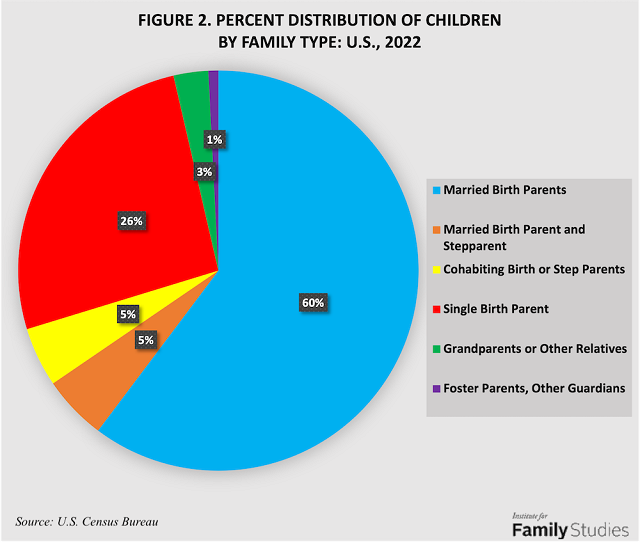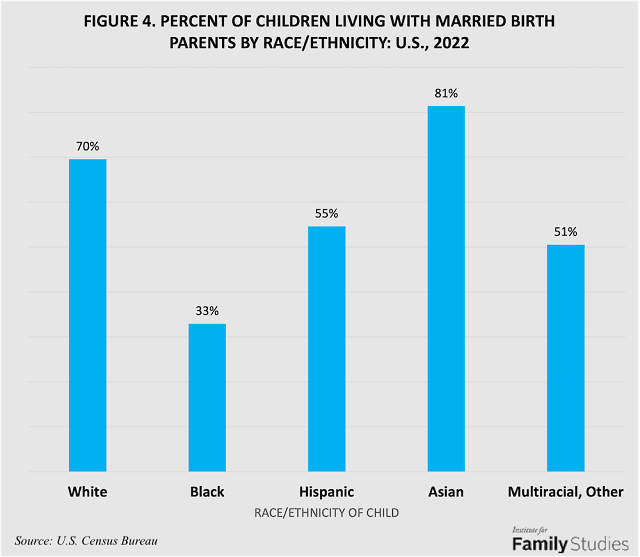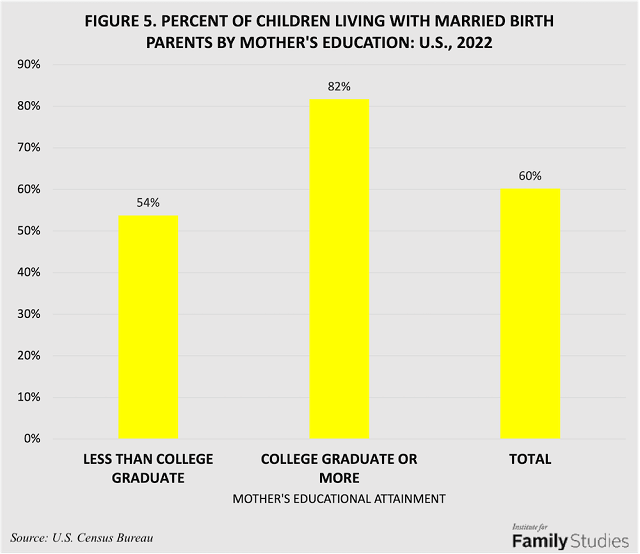Highlights
- In 2023, the proportion of children in two-parent families increased to 71 percent. Post This
- Children whose parents are college graduates or have graduate or professional degrees are more likely to be living with married birth parents. Post This
- Two developments that promise to extend the resurgence of the traditional family are the older ages at which adults embark on parenthood and the increased numbers of recent immigrants. Post This
In 2021, I reported that the proportion of children living in traditional two-parent families had stopped declining and appeared to be increasing or at least levelling off. The number of children under 18 living with two parents had fallen from 88% in 1960 to just over two-thirds in 2005, as may be seen in Figure One. And the proportion living with divorced, separated or never-married single parents tripled from 9% to 28%, while the proportion living with neither parent (that is, with grandparents, other relatives, or foster parents) inched up from 3 to 4½ percent.
But then, contrary to expert prognostications, the proportion of children living with two parents gradually recovered, reaching 70% in 2020. And the fraction living in one-parent families slipped from 28% to less than 26%, while the number living with neither parent levelled off between 4 and 5 percent.

The latest readings from the U.S. Census Bureau show that in 2023, the proportion of children in two-parent families increased to 71 percent. The fraction in single-parent families decreased to 25%, while the proportion with neither birth parent declined slightly to under 4 percent.
Children Living With Both Married Birth Parents
As also noted previously, the Census Bureau’s two-parent trend analysis includes children living with a birth parent and stepparent and couples who are cohabiting without being married. If we separate out the children in stepfamilies and unmarried-couple families, we get the picture shown in Figure Two.

A 60% majority of American children lived with both married birth parents in 2022.1 Just over 5% were in birth parent-stepparent families where the birth parent had remarried. And just under 5% lived with cohabiting birth parents or in birth parent-stepparent households.
Furthermore, 26% of children lived in single-parent households in 2022, 21.5% with birth mothers, and 4.6% with birth fathers. And 22.5% had single parents who lived alone, while 3.6% lived with single parents who cohabited with another adult.
About Half of Children Have Benefited From an Intact Family
How many American children not only lived with both birth parents at a given point in time but were raised by both birth parents throughout their childhood? One way of estimating this proportion is to examine the living arrangements of 15 to 17-year-old adolescents. The fact that these older teens were still living with their married biological parents means that the vast majority grew up with them since birth. Some may have been born to unmarried parents who subsequently got married during the student’s childhood. And some may have experienced parental conflicts or temporary separations, but not the kind of conflict that resulted in permanent splits. Their parents were able to work things out and the marriages endured.
Figure Three shows the proportion of U.S. children who lived with married birth parents in 2022, in each of three age groups: Birth to 5 years old, 6 to 14 years old, and 15 to 17 years old. As the figure illustrates, the proportion declined from 64.9% to 53.6%. Thus, the current estimate of the percent of American children who grow up in intact families is 54 percent. This represents a slight increase from the previous estimate, which was 50.6 percent. But it is still below the 1996 estimate of 60.4%, not to mention the still higher proportions that prevailed in the middle of the 20th century.

Continuing Racial Disparities in Two-Parent Families
There are continuing gaps across racial and ethnic groups in the proportion of youngsters who benefit from living with both married birth parents. As may be seen in Figure Four, in 2022, 81% of Asian children lived with both married birth parents. So did 70% of white children, 55% of Hispanic children, and 51% of multiracial children. Only one-third of Black children lived with married birth parents.

The College Graduate Divide Persists
Children whose parents are college graduates or have graduate or professional degrees are more likely to be living with married birth parents. Among those whose mothers had bachelor’s degrees or more, 82% lived with married birth parents. By contrast, the same was true of only 54% of those whose mothers had less than a college education.

False Prophets and Reasons for Expecting Further Recovery
The trends reviewed here show us that those who predicted a relentless increase in family instability or single parenthood were simply wrong. There seem to be growing numbers of young adults in all racial and ethnic groups who realize the economic, educational, and emotional benefits of marriage for themselves and their future children. As parenthood becomes more selective, the marriage-minded may have an advantage in childbearing.
Two developments that promise to extend the resurgence of the traditional family are the older ages at which adults embark on parenthood nowadays and the increased numbers of recent immigrants in the U.S. population. Women and men who begin having children in their 30s and 40s are more likely to marry beforehand and stay married. Likewise, recent immigrants have shown a propensity to marry before having kids and then to remain married.
Nicholas Zill is a research psychologist and a senior fellow of the Institute for Family Studies. He directed the National Survey of Children, a longitudinal study that produced widely cited findings on children’s life experiences and adjustment following parental divorce.
1. This figure includes about one percent of children who live with two married adoptive parents.











